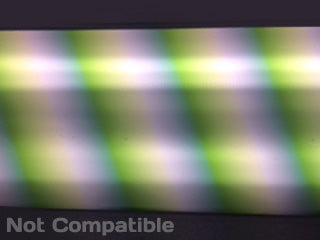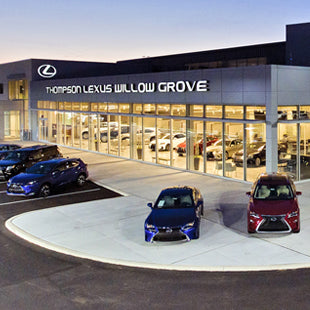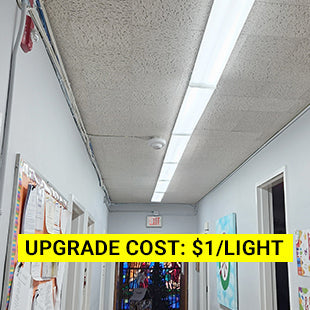Magnetic vs. Electronic Ballasts—An Easy Way to Tell Which You Have!
Understanding LED Tube Types for Your Fluorescent Fixture Upgrade
Last updated October 2025
When upgrading your fluorescent fixtures to LED, understanding your ballast type and LED tube options is crucial for a successful retrofit. Today's LED tubes come in several types, each with distinct installation requirements and benefits.
LED Tube Type Classifications
Modern LED tubes are categorized using industry-standard classifications:
Type A (Plug-and-Play/Ballast-Compatible): These tubes work with your existing electronic ballast. Simply replace the fluorescent tube with the LED tube—no rewiring required. However, compatibility with your specific ballast model must be verified.
Type B (Ballast-Bypass/Direct-Wire): These tubes connect directly to line voltage after the ballast is removed or bypassed. They offer maximum energy efficiency and eliminate ballast maintenance, but require rewiring the fixture.
Type A+B (Hybrid/Universal): These versatile tubes can operate either with a compatible electronic ballast OR as a ballast-bypass tube. They provide excellent flexibility—start with plug-and-play installation, then bypass the ballast when it eventually fails.
Type C: These systems use LED tubes with specially designed LED drivers, offering advanced features like dimming and adjustable lumen output.
Why Ballast Type Matters
Type A tubes generally don't work with magnetic ballasts, and installing them with one can damage the tube's electronics. Magnetic ballasts operate at 60Hz, while electronic ballasts run at much higher frequencies (20,000-60,000Hz), which affects both efficiency and compatibility.
The Smartphone Detection Method
Here's a quick way to determine if you have a magnetic or electronic ballast:
How to Test:
- Turn the light on
- Open your smartphone camera or use a digital camera
- Take a photo or video of the lit fixture
- Examine the image
Reading the Results:
- No dark bands visible: You likely have an electronic ballast that may work with Type A (plug-and-play) LED tubes
- Dark horizontal bands visible: You have a magnetic ballast and must use Type B (ballast-bypass) tubes
Why This Works: The method detects flicker frequency differences. Magnetic ballasts flicker at 60Hz (visible to cameras), while electronic ballasts operate at higher frequencies that most cameras cannot detect.


Important Notes:
- Some modern smartphones with very high frame rates may not show bands as clearly—try video mode if the photo is unclear
- This is a quick screening method; checking the ballast label is definitive
- Take multiple photos from different angles if results are unclear
Important Compatibility Considerations
Even if you have an electronic ballast, compatibility isn't guaranteed:
Ballast Compatibility Lists: Always check the manufacturer's compatibility list for your specific LED tube. Electronic ballasts come in many varieties (rapid-start, instant-start, programmed-start), and not all work with every Type A tube.
Ballast Age and Condition: Older ballasts or those nearing end-of-life may cause performance issues even if technically compatible. Ballasts typically last 10-15 years.
Socket Type Requirements: Type B installations may require specific socket types:
- Shunted vs. Non-Shunted: Check whether your LED tubes require non-shunted sockets (also called tombstones). Some fixtures have shunted sockets that must be replaced for Type B tubes.
- Polarity-Neutral Tubes: Newer designs work with both socket types, eliminating this concern.
Comparing Your LED Tube Options
Type A (Plug-and-Play) Tubes
Advantages:
- Easiest installation—no rewiring
- Can revert to fluorescent tubes if needed
- No electrical work required
Disadvantages:
- Must verify ballast compatibility
- Ballast continues drawing 2-3 watts per tube
- When ballast fails, tubes may stop working
- Ongoing ballast maintenance required
Best For: Quick retrofits with newer electronic ballasts in good condition
Type B (Ballast-Bypass) Tubes
Advantages:
- Maximum energy efficiency—eliminates ballast draw
- No ballast maintenance or future ballast failures
- Longer system lifespan
- Works with any fixture after rewiring
Disadvantages:
- Requires rewiring (disconnect ballast, connect sockets to line voltage)
- May need socket replacement in some fixtures
- Creates safety considerations (see below)
Best For: Long-term installations, aging ballasts, maximum energy savings
Type A+B (Hybrid) Tubes
Advantages:
- Start with plug-and-play convenience
- Switch to ballast-bypass when ballast fails
- Maximum flexibility and future-proofing
- Insurance against ballast failure
Disadvantages:
- Typically more expensive than single-type tubes
- Still requires checking ballast compatibility initially
Best For: Installations where you want flexibility and don't want to rewire immediately
Energy Savings Breakdown
Understanding the energy benefits helps justify your choice:
- Fluorescent T8 tubes: Typically consume 32W per tube
- LED tubes: Use 8-20W per tube (60-75% reduction)
- Ballast draw: Adds 2-3W per tube in Type A installations
- Type B advantage: Eliminates ballast draw entirely
Example: A 4-tube fixture using 18W LED tubes
- With ballast (Type A): 72W + ~10W ballast = ~82W total
- Without ballast (Type B): 72W total
- Annual savings from eliminating ballast: ~87 kWh per fixture
Critical Safety Information for Type B Installation
⚠️ IMPORTANT SAFETY WARNINGS:
Type B (ballast-bypass) installations create a shock hazard because the sockets carry line voltage (120V or higher). Follow these safety guidelines:
- Always turn off power at the breaker—not just the light switch
- Use double-ended tubes rather than single-ended tubes whenever possible for safer installation
- Never touch the tube pins during installation, as they may be energized
- Verify power is off with a voltage tester before beginning work
- Consider hiring a licensed electrician if you're uncomfortable with electrical work
Single-ended Type B tubes are particularly risky because it's natural to place a finger on the pins while installing—this becomes dangerous when those pins are energized.
Making Your Decision
Use this decision guide to choose the right LED tube type:
Choose Type A if:
- You have a newer electronic ballast in good condition
- You've verified compatibility with your specific ballast model
- You want the quickest, easiest installation
- You're comfortable with eventual ballast replacement
Choose Type B if:
- You have a magnetic ballast (required)
- Your electronic ballast is old or failing
- You want maximum long-term energy savings
- You want to eliminate all future ballast maintenance
- You're comfortable with basic electrical work or hiring an electrician
Choose Type A+B if:
- You want the best of both worlds
- You're unsure about ballast condition
- You want to future-proof your installation
- Budget allows for the higher initial cost
Why ELEDLights Focuses on Type B Tubes
At ELEDLights, we primarily carry ballast-bypass (Type B) LED tubes because they offer:
- Superior long-term value: No ongoing ballast maintenance or replacement costs
- Maximum efficiency: Eliminate parasitic ballast draw
- Greater reliability: Fewer components that can fail
- Universal compatibility: Works with any fixture after a simple rewiring
The rewiring process is straightforward: disconnect the ballast from the circuit and wire the sockets directly to line voltage. While this requires more initial effort than plug-and-play, the long-term benefits far outweigh the installation time.
Shop LED Fluorescent Replacement Tubes
Our Commitment to Quality
All our lights are backed by solid warranties and supported by USA-based customer support. If you're not satisfied with the quality or the light won't work for your application, you can send it back within 30 days in its original packaging for a full refund.
We carry lights for all applications:
- Standard office fixture replacements
- Ultra-bright lamps for high bay fixtures
- Specialized solutions for unique requirements
Need help choosing? Our team can assist with:
- Identifying your specific ballast model
- Recommending compatible tubes for your application
- Providing guidance for ballast-bypass installation
- Finding the right solution for your unique needs
Looking for a Lighting Supplier You Can Count On?
Check out the top 3 reasons customers choose ELEDLights:
Contact Us:
- Phone: 215.355.7200 or 858.650.9400
- Email: lights@eledlights.com





